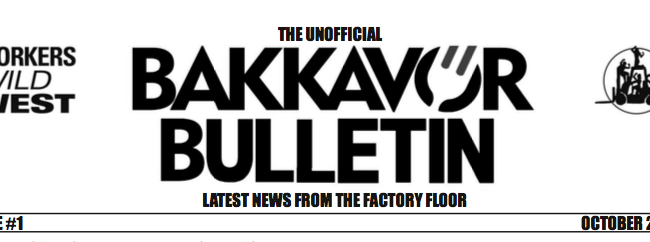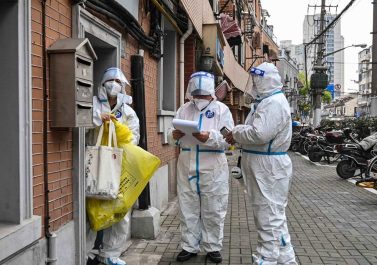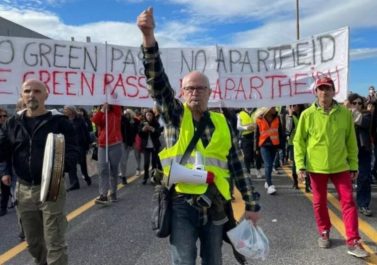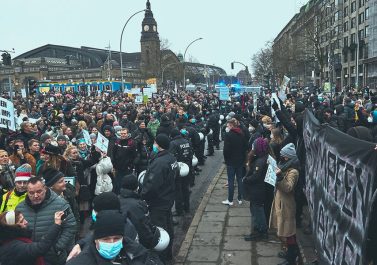(Translation from: https://solidarischgegencorona.wordpress.com/2020/11/24/immunitat-und-die-fesseln-der-produktion/)
While some Asian countries are pursuing an eradication strategy in dealing with the Covid 19 pandemic, Western governments are pursuing a less ambitious goal – “Flatten the curve”. This does not mean putting an end to the infection, but just a slowing down of the process. One problem with this strategy is that “herd immunity” builds up only very slowly so containment measures, such as lockdowns, would have to remain in force for many years to come: a terrible prospect.
Against this background, great hopes have been placed in the development of vaccines since spring 2020. A successful vaccine could spare us the fear of infection, put an end to contact restrictions and enable a rapid return to normality. Various scientific breakthroughs in vaccine development in the autumn of 2020 have given fresh hope for an early release from the pandemic.
However, despite all the justified joy at promising scientific and pharmaceutical successes, we must keep an eye on the social, political and economic relations within which technological innovations take place. All too often capitalist ownership and production relations prevent the realization of the great potentials that lie dormant in science and technology. The best drug is of no use if capitalist pharmaceutical companies sell it at prohibitive prices or stop production because of the lack of profitability.
Liberal optimism, which focuses on technological solutions for complex social crises such as the pandemic or climate change, is often dashed. Meanwhile the people who base their criticism of the “pharmaceutical lobby” on conspiracy stories and natural remedies are also completely on the wrong track. The problem with the capitalist pharmaceutical industry is not that it develops vaccines to allegedly deceive and enslave people but the exclusion of large parts of the world’s population from benefiting from its discoveries.
It would be wrong, however, to dispense with a necessary critique of the capitalist health industry on the basis of such misconceptions. The present text offers some important thoughts on this.
———
With the second wave of the Covid 19 pandemic, public reporting on possible vaccines is gaining in importance compared to hygiene and containment measures. It is often suggested that the approval and distribution of a vaccine will put an end to fears about the health consequences of a possible infection and the hated restrictions on individual freedom. These hopes of salvation are fed by the bourgeois illusion that in the present society the first aim of production is to meet the needs of the people. The economic reality is different. How we deal with this contradiction will determine how existential the threat of this and coming pandemics is for the world’s population.
First of all it must be said that the research and development of possible Covid vaccines to date is a history of unprecedented medical success. The development of drugs usually takes years or even decades. In the case of Covid-19, however, Russia and China developed vaccines weeks ago, tested them successfully and made them available to medical personnel.1 Meanwhile, a U.S.- German joint venture and another U.S. company have also presented initial results of the third test phase, crucial for the evaluation of the medical effect. All results are far beyond the expectations and experience of previous vaccine research. But what are the actual conditions of these successes, which are interpreted as decisive steps “back to normality”?
Pharmaceutical industry: public research, private profits
Drug development is a prime example of public-private partnership. Basic research is usually far too time-consuming and costly for pharmaceutical companies to conduct themselves. Therefore, it is usually carried out at universities and research institutes with public financial and infrastructural resources. However, these do not have the facilities to turn their discoveries into mass production. They have to sell their results to pharmaceutical companies who turn this knowledge into production and profits.
Commercial research in some areas of pharmacology has declined to such an extent that there are discussions about forcing corporations to produce certain drugs. The British Medicine Journal published a discussion in March entitled “Is it time to nationalise the pharmaceutical industry? “2 For example while the development of antibiotics used to be a relatively simple and profitable business, they are now being used less and less for fear of multidrug resistance. So for pharmaceutical companies, the incentive to do any research in this field has disappeared due to declining demand.3
Vaccine research is also considered extremely unattractive, because its aim is to eliminate the disease and thus end demand for the product. The Sars-CoV-2 vaccines also basically follow the pattern of public burdens and private profits. Some states currently subsidize pharmaceutical companies on a massive scale while also being supported in their work by universities and research institutes. In this way, the states give the companies a financial guarantee – even in the event of failure – but secures a privileged access in the event of a successful product.
Cooperation and capitalization
In view of the successes in the current “race” for a vaccine against Sars-CoV-2, the pharmaceutical lobby is painting a success story of competition and international cooperation. But isn’t there a contradiction here? How do competition and cooperation go together?
Researchers at the Public Health Clinical Centre and the School of Public Health in Shanghai decoded the virus’ genome and made this knowledge publicly available on January 10, 2020. This created the basis for further research and development 4 and gave the starting signal for the private research teams. None of the pharmaceutical companies that have since been working on their vaccines as competitors could have started development without this open access to basic knowledge.
Drug companies’ patents are the legally documented expression of these private producers, who operate in competition and secrecy with each other. Since the individual vaccines differ from each other, the companies can have their vaccine candidates patented independently of each other. An oligopoly of a few companies secures the market through patent protection, and the possibility of achieving high prices in times of scarcity. Producers who do not have enough capital for their own development are left out. While rich countries pay hundreds of millions for access to the vaccines, the resulting high prices primarily affect poorer parts of the world.
Patent protection is certainly perceived as a problem by parts of the public (without, however, naming it as a natural expression of capitalist production). Two prominent cases are discussed as exceptions to the insistence on patent rights. One is the therapeutic drug Remdesivir. For Remdesivir, the US manufacturer Gilead has issued licenses that allow certain generic manufacturers to produce and distribute the drug in unlimited quantities free of charge. It is assumed, however, that Gilead’s announcement of these voluntary license agreements was primarily a reaction to negative headlines. Remdesivir was originally developed as an Ebola drug but was not approved. At the beginning of the year, Gilead obtained a special approval as a Covid drug. The US government was able to present an alleged “breakthrough” against the disease and Gilead had found a way to get rid of its drug after all. There were no medical reasons for the special approval. Gilead’s stockmarket valuation has since ceased to soar and Remdesivir is traded as largely ineffective against Covid-19.5
In mid-November, Moderna was the second U.S. company after Pfizer/Biontech, to present promising initial results from the decisive third test phase of its vaccine. In October, Moderna had announced that it would partially refrain from enforcing its patent rights during the Covid pandemic.6 Moderna is a pioneer of mRNA technology, which is intended to replace traditional vaccines. The company is itself fighting against several patent infringement proceedings. So its announcement is a double move. On the one hand it hopes to deflect the legal proceedings against it because Moderna is able to present an open attitude towards patent law issues under the pressure of the pandemic. On the other hand, the group is using the situation to push its own technology to new prominence and gain larger market shares. However, so far its promises are just that – promises. Aside from the legal issues, it would be important to share extensive production knowledge but a renunciation of the prosecution of patent law “during the pandemic” does not mean that retroactive proceedings will not follow.7
For many countries in the global South, the mRNA vaccines from Moderna and especially from Pfizer & BionTech are not a good solution anyway, as they have to be stored and transported at very low temperatures – limiting the ability of some countries to use it because of their climate and poor medical infrastructure. For these markets, for example, the British company AstraZeneca or the Chinese producer Sinovac have suitable “solutions” ready with their classic inactivated and vector-based vaccines. Of course, these are not cheap either. For example, China is offering special credit programs to the Philippines and several Latin American countries so that they can buy their own vaccines in large quantities.
The charity complex
The fact that large parts of the world have either limited or no access to medicines is nothing new. Pharmaceutical companies generally tend to set high prices for drugs instead of making them available to the masses at low cost. In recent years, this practice has reached new dimensions through stock market speculation on the prices of vital drugs.8 However, for some drugs, especially vaccines, there has also been a remarkable shift in the last 20 years toward increased sales to economically weaker countries.
After the UN had included a reduction in child mortality in its Millennium Development Goals in 2000, GAVI, an NGO, came on the scene and began to subsidize the production and distribution of vaccines to the tune of billions of dollars.9 The project is considered a great success, tens of millions of lives were saved through its “commitment”.10 This ‘success’, however, means that the problem of distributing burdens and profits at higher levels is simply repeated. Gavi is financed by foundations and state funds.11 Nation states, as the largest donors, finance their own corporations across the board through donations to GAVI – with tax revenues, i.e. ultimately at the expense of their wage-dependent population. The foundations themselves, in turn, sometimes hold shares in the pharmaceutical companies.
GAVI was also quickly appointed as the key player in solving the distribution problem in the Covid-19 case. Under the umbrella of the WHO, GAVI is working in the COVAX project on the question of how Covid vaccines can be financed and distributed according to epidemologically meaningful criteria. But the principle developed only works if as many countries as possible purchase their vaccines through COVAX, accepting its distribution criteria. In fact, only poorer nations will purchase vaccines via COVAX, while rich countries and communities of states can supply themselves according to their own calculations and with all the power of the money providers.12 The latter buy vaccines for the majority of their population. For example, the EU has already concluded a contract with Pfizer/BionTech for 300 million doses, of which Germany claims a disproportionately high share of 90 to 100 million doses. The German government had supported the German company BionTech with almost 400 million euros. As far as the supply of the COVAX states is concerned, there are very few concrete figures to date. Initially, a supply of approx. 20% of the population is expected.13
Productive forces and destruction ratios
The fact that poor states are kept in a form of neo-colonial dependence by the prevailing global competitive and power relations in production, trade and credit is not a new phenomenon. In addition to the production of medicines, this also affects other medical material such as respirators. In many places, international trade agreements and corresponding patent rights have already undermined the possibilities of building up corresponding production capacities.
Even though patent rights are suspended and production knowledge is shared on a large scale is this is often of little concrete use. Requests from the NGO world or representatives of poorer states remain meaningless since they do not identify the power of pharmaceutical capital and the will of the rich industrialized countries to put their profit interests above more reasonable forms of production and distribution. Such a change requires forms of social control and global coordination that are geared to concrete needs. This, in turn, requires social power relations that impose the needs of the wage-earners against those of capital.
Even if such notions of socialization of production are currently not very realistic, the material prerequisites for a faster and above all more favourable supply to people certainly exist. Innumerable generic manufacturers across the world already produce medicines, which after ten to twenty years are no longer subject to the patent protection and they produce them at a fraction of the original price. And the power of the industrialized nations, mainly enshrined in trade agreements, is not undisputed either. In some cases, states already refuse to recognize existing patent protection or to grant patents if this means that the prices of the respective drugs are no longer affordable for their own populations.14
The step toward deprivatization and depatenting would not only be relevant in economic terms. If a large proportion of the world’s population is not adequately supplied with the necessary vaccines, in the case of Covid-19 and future viruses, their control and containment as a whole is at stake. If large parts of the world do not have sufficient access to the vaccine, Covid-19 could spread further, mutate and in another form reach the global North. Covid could – similar to influenza – be impossible to eradicate and could return again and again.
Agriculture, livestock breeding and urbanization in its capitalist form must be understood as the main cause of the emergence and spread of pandemics like Covid-19.15 In turn, the reason why we cannot end the pandemic is because the retention of vital knowledge is sold as a right of private property and the competition between owners and states is transformed seemingly into a state of nature. A real movement against the pandemic would have to have the power to break up this capitalist ‘natural state’ and put the reorganization of global production relations on the agenda.
1 https://www.clinicaltrialsarena.com/news/russia-sputnik-v-efficacy/
2 https://heatinformatics.com/sites/default/files/images-videosFileContent/bmj.m769.full_.pdf
4 https://www.ecdc.europa.eu/en/covid-19/timeline-ecdc-response
https://virological.org/t/novel-2019-coronavirus-genome/319
5 https://theintercept.com/2020/03/25/gilead-sciences-coronavirus-drug/
7 https://www.ipwatchdog.com/2020/11/11/breaking-modernas-covid-19-patent-pledge/id=127224/
9 https://www.who.int/workforcealliance/members_partners/member_list/gavi/en/
10 https://ourworldindata.org/vaccination
11 https://www.aerzte-ohne-grenzen.de/forschungsplattform-cepi
12 https://de.reuters.com/article/virus-who-deutschland-idDEKBN2692AQ
14 https://thebaffler.com/salvos/drugs-for-the-people-neumann



